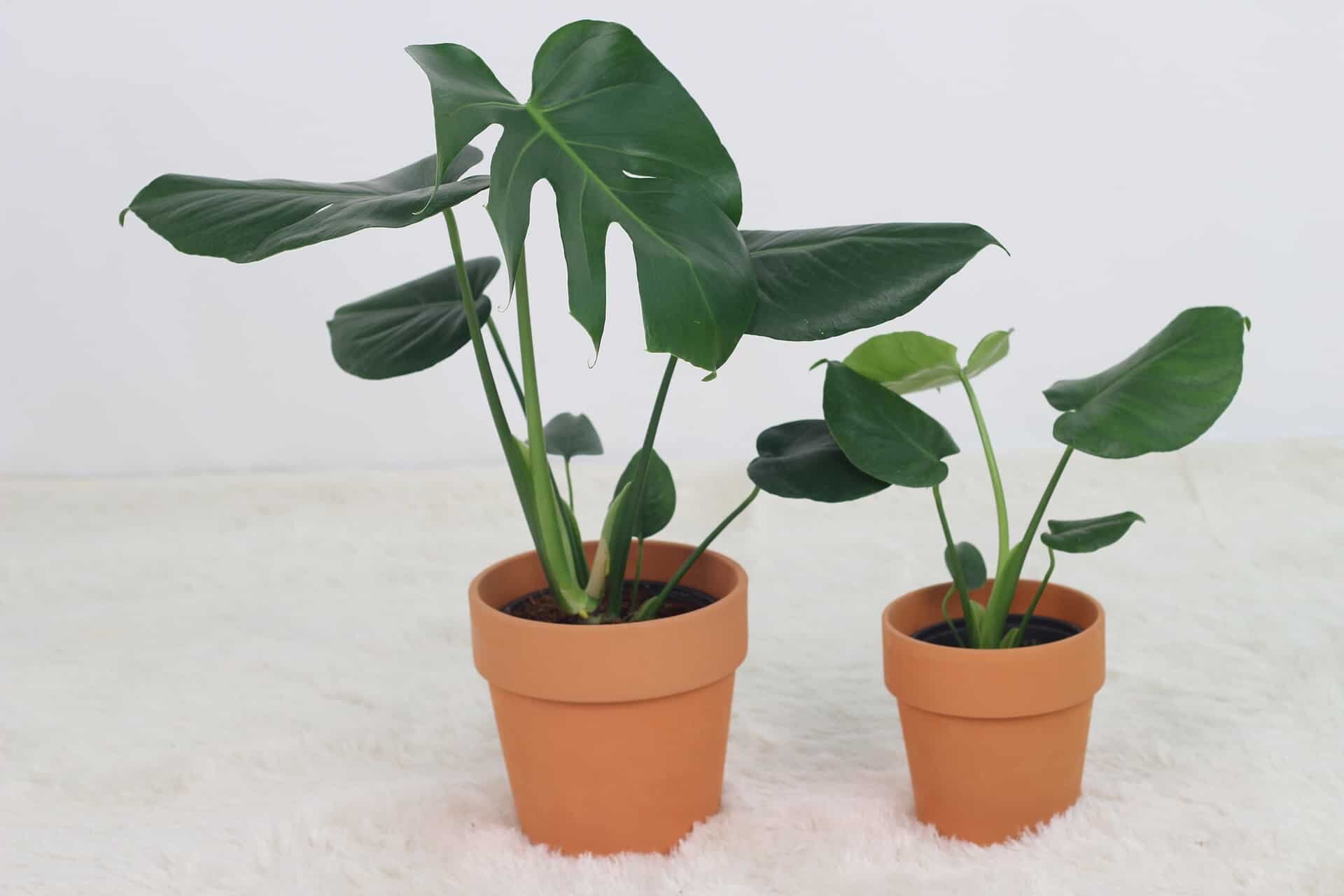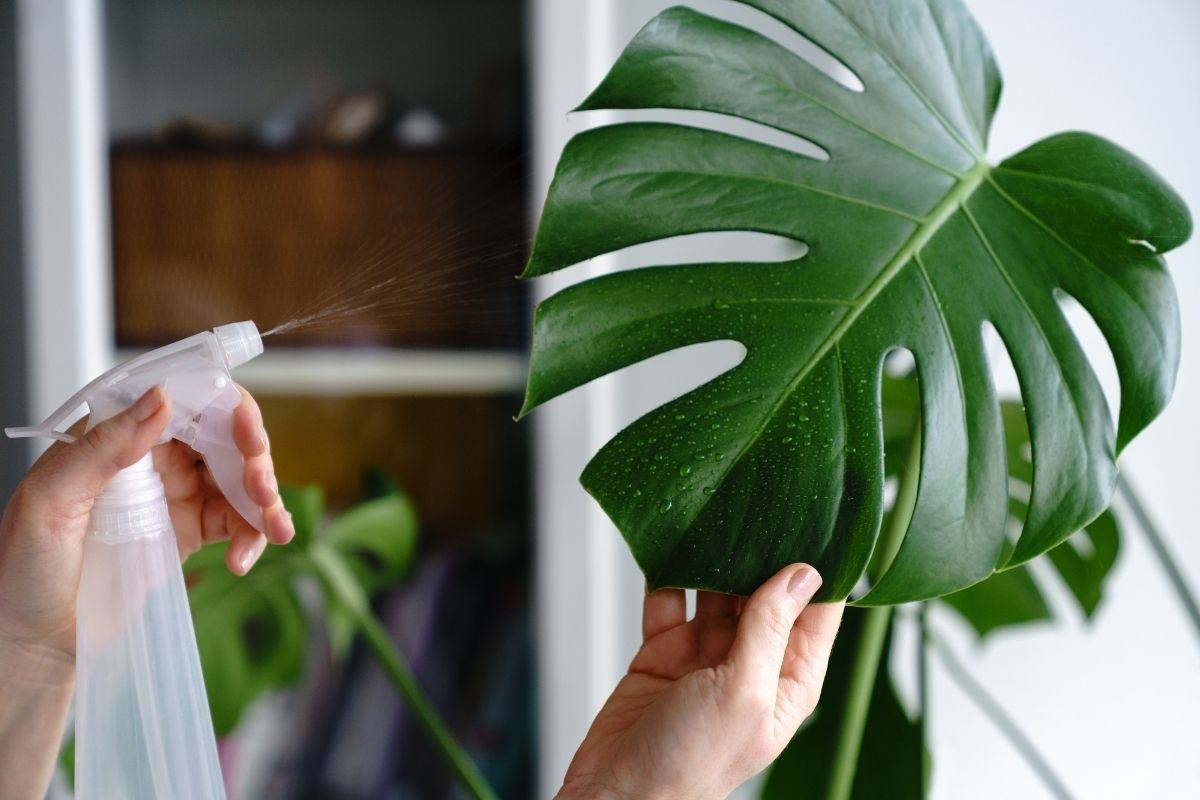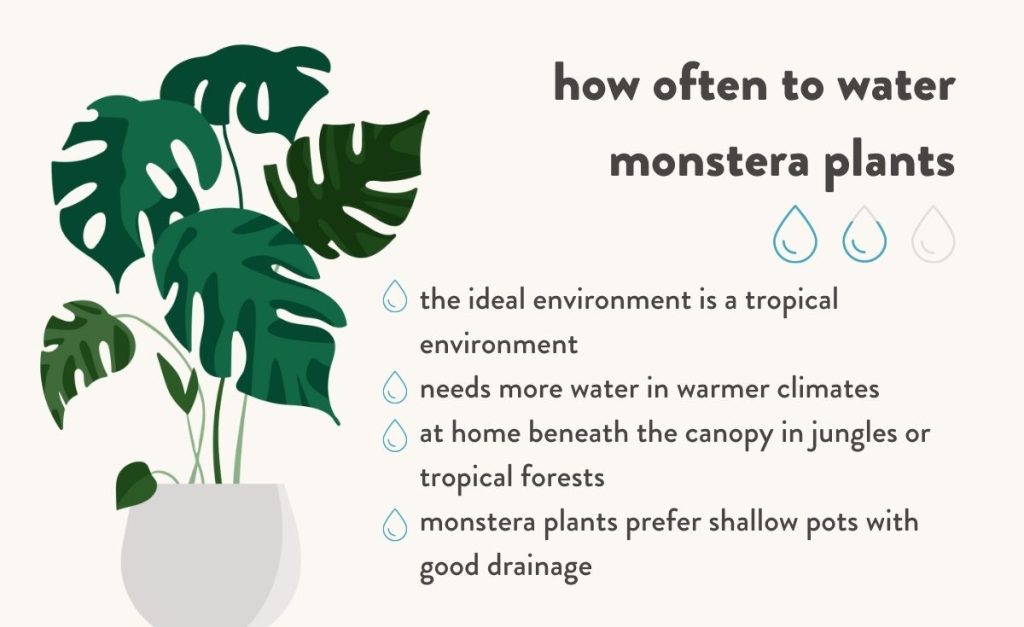
Give monstera a good soak to ensure that any extra water drains out of the drainage holes in the pot’s base. Regularly misting the leaves with water can promote humidity. When the top inch of soil begins to feel dry, water monstera.
Monstera deliciosa, often known as the Swiss Cheese Plant, has leaf edges that can turn brown from underwatering and low humidity or yellow from overwatering and containers without drainage, so it’s crucial to know how much and how frequently to water it.
Because they can go dormant in temperatures between 55°F (12°C) and 65°F (18°C) throughout the winter, monstera plants have variable watering needs at different times of the year. During the spring and summer, when they are actively growing, they need less watering.
For more information on how to water your monstera plant at different times of the year and in your climate, keep reading.
Table of Contents
How Often to Water Monstera
A native of the tropical rainforests of Mexico, Central America, and Brazil, Monstera deliciosa thrives in hot regions with high humidity, regular rainfall, and moist soils.
Due to its adaptation to rainforest circumstances, monstera is particularly vulnerable to issues with inadequate moisture and low humidity, which cause the leaves to droop and become brown at the edges as a symptom of drought stress.
However, if the soil is saturated from excessive watering or drains too slowly, the monstera can also develop root rot, which causes the leaves to become yellow.
In order to successfully grow monstera indoors, it’s critical to replicate the increased humidity and regular watering of their natural habitat.
The soil must be consistently damp, but not soggy, for monstera plants to grow. To meet the needs for moisture and prevent root rot, let the top inch of the soil dry between waterings. Typically, this entails giving your plants a good soak once every seven days, though this depends on the weather and other factors.
However, maintaining humidity is just as crucial as providing adequate watering.
Spray the monstera leaves with a mist sprayer regularly to create a humid micro-climate. This preserves the healthy green color of the leaf margins, lessens water loss from the leaves, and mimics the humidity of the rainforest where the plant originally lived.
How often you have to water your monstera and mist the leaves depends on numerous things such as:
- Temperature and humidity in your environment as well as inside your house.
- How big the pot is (smaller pots dry out much quicker).
- Whether your monstera is exposed to strong air currents from draughts, forced air, air conditioning, or conventional currents brought on by interior heating.
- the soil’s ability to hold onto moisture.
In your home, feel the top inch of soil to determine how frequently to water your monstera plants.
If the soil seems saturated then scale back the watering and ensure the pots drains adequately.
When the top inch of soil feels as though it is beginning to dry out, watering should be delayed if the earth feels damp.
When you know how long it usually takes for the top inch of soil to dry up around your monstera, you can create a watering schedule that precisely replicates the soil’s natural moisture levels.
How to Tell if you are Watering Monstera too Often or not Often Enough
Although this might also signify a shortage of nutrients in the soil and the need for a general house plant fertilizer, the yellowing and drooping of the leaves are a sign of an overwatered monstera.
Reduce watering immediately if you detect the leaves turning yellow because overwatered monstera can suffer from root rot and eventually die.
Make sure the soil is not stuck and that any extra water may flow freely from the pot’s base.
Under watered monstera turns brown at the leaf margins and droops, which is also an indication of low humidity.
In contrast to the humid circumstances of the monstera’s native rainforest, air currents rob moisture from the leaves.
As often as three times each week, spray your monstera if the leaf margins are becoming brown.
Keep in mind that increasing watering is not always essential because stress is frequently brought on by low humidity, which is a typical issue in many houses.
Only increase the frequency of watering monstera if the container is rapidly drying out. Keep the soil evenly moist by only watering when the top inch feels dry.
(Read my essay on how to save a monstera from death.)
How Often to Water Monstera in Winter
Bright indirect light is ideal for monstera development, thus growth can slow down dramatically in the winter, reducing the need for watering.
At temperatures constantly between 55°F (12°C) and 65°F (18°C) your monstera plant remains dormant.
If the temperature is in this range, water the monstera once every two to three weeks to prevent root rot and to make sure the soil does not entirely dry out.
Even if the plant is dormant, spray the leaves at least once a week because wintertime houses frequently have very low humidity levels.
However, keep in mind that throughout the winter, residences may experience temperature fluctuations, and sources of heat may dry out pots more quickly than usual.
Choose a location for your potted monstera that is away from any source of heat, keep an eye out for signs of drought stress like drooping leaves, curling leaves, or brown leaf edges, and adjust your watering and misting as necessary.
How Often to Water Monstera in Summer
Given that this depends on your particular environment and conditions, it would be reckless to recommend a set watering frequency in the summer.
However, throughout the summer when the plant is actively developing, you should increase your watering and maintain humidity by misting the leaves at least once per week or more, especially in dry locations.
For most houses, watering your monstera once a week in the summer with a deep soak is ideal. However, you should always check the soil to see when the top inch begins to feel dry since this is when you should water in your particular conditions.
How to Water Monstera

Although the frequency of watering monstera plants can vary depending on climate, humidity, and temperature, the volume of water should remain constant.
Give the mosntera a generous soak, letting any extra water drip out the pot’s bottom.
This guarantees that the water has adequately soaked into the soil, allowing the roots to absorb the necessary moisture.
A generous watering also promotes the establishment of the roots, which is beneficial for the health of the plants and further strengthens their resistance to drought.
A monstera’s leaves will droop and become brown as a symptom of drought stress if they are watered insufficiently, which results in only the top inch or so of the soil being moist and prevents the water from penetrating the soil and reaching the roots where it is needed.
To mimic the soil’s moisture levels in the tropical rainforest habitat of the monstera, water thoroughly and then let the top inch begin to dry out.
Grow Monsteras in Pots with Drainage holes so Excess Water Escapes

The easiest way to make sure the monstera has been adequately hydrated and that the water has permeated the soil so that it is evenly moist is to water until water trickles from the base of your container.
If you plant monstera in pots without drainage holes or the drainage holes as plugged then this causes water to pool around the roots and the monstera leaves droop, turn yellow and die from root rot.
If: Water may still collect around the monstera roots in your pot.
- Roots or compacted soil can obstruct the drainage hole. It is worth checking to see if you need to clear the drainage hole at the base to allow water to leave freely if you discover that your soil is draining slowly or not at all.
- trays and saucers beneath your pots In order to stop water from dripping into your home, it is fairly customary to place a saucer or tray underneath your plant pot. To avoid root rot, regularly empty the saucer or tray to avoid water accumulating and keeping the soil wet rather than equally moist.
- outside pots that add style. Sometimes, monstera are offered in stores in a plastic pot with drainage holes that looks nice and keeps water from pouring inside your house. However, the outer pot may stop excess water from dripping out and may keep the soil moist around the roots, which leads to root rot. To avoid this, either dump the water from the pot frequently or plant in a pot with drainage holes in the bottom.
(Read my post on how to preserve a yellow-leaved monstera.)
Key Takeaways:
- When the soil in the top inch of the plant begins to dry out, water the monstera deliciosa plants. To make sure the water has permeated the soil and reached the roots, monstera should always receive a generous soak. To keep the humidity level high, often mist the monstera leaves with water.
- Underwatered or in low humidity, monstera plants turn brown and droop. Overwatered or in saturated soils, monstera wilts and becomes yellow.
- In milder climates, monstera becomes dormant and frequently needs less water in the winter and fall than it does in the spring and summer.
- Make sure the monstera is not in the way of air currents or drafts, and wet the leaves frequently to create a humid microclimate that resembles the rainforest habitat of the monstera.
